Sustainable Enterprise and Social Responsibility
VerifiedAdded on 2023/06/10
|15
|4502
|186
AI Summary
The assignment focuses on the concepts of sustainability and corporate social responsibility. A literature review is conducted on the principles of CSR and sustainability. The case study of Nokia and its CSR practices is discussed.
Contribute Materials
Your contribution can guide someone’s learning journey. Share your
documents today.

RUNNING HEAD: Sustainable Enterprise and Social Responsibility
Secure Best Marks with AI Grader
Need help grading? Try our AI Grader for instant feedback on your assignments.
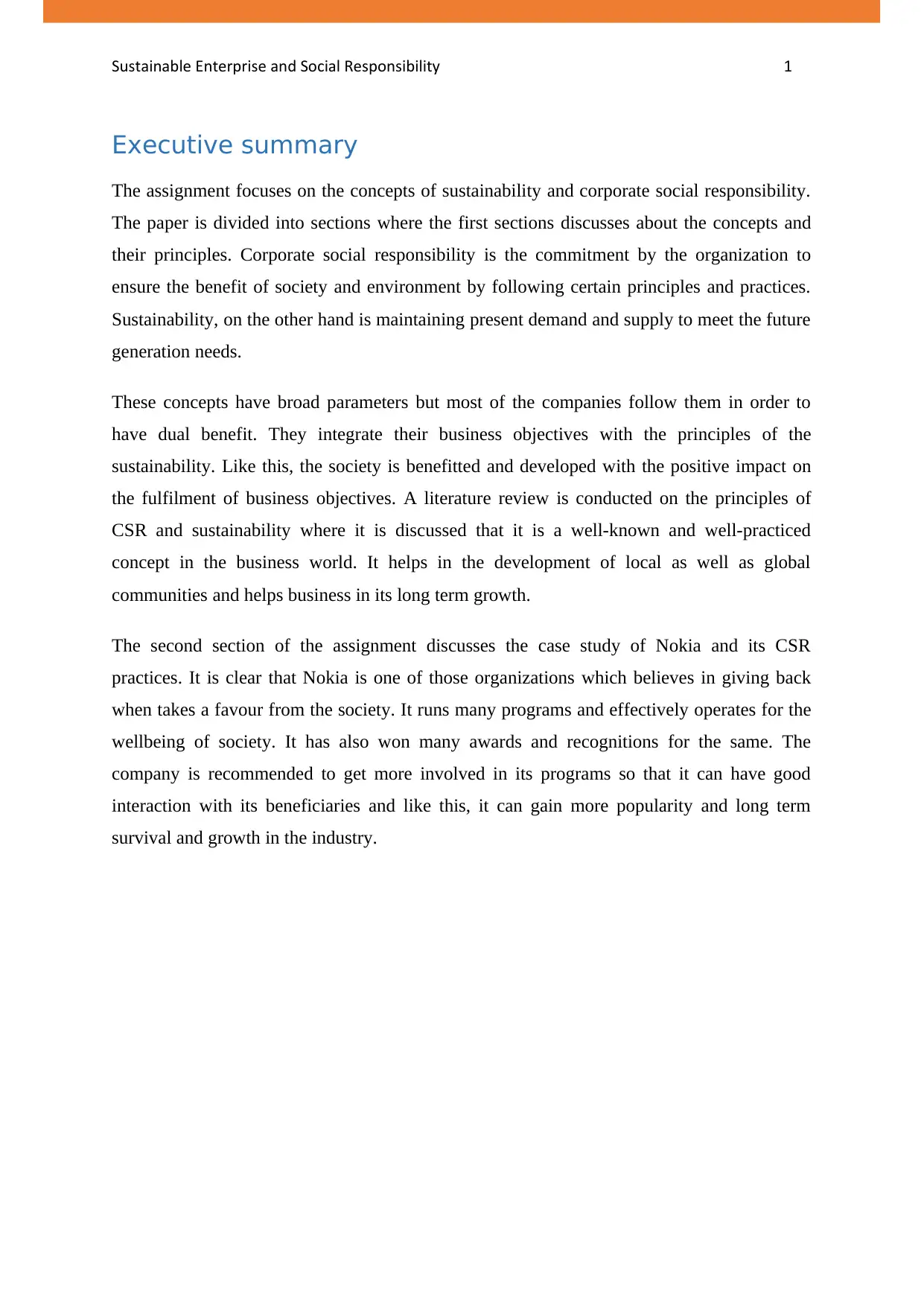
Sustainable Enterprise and Social Responsibility 1
Executive summary
The assignment focuses on the concepts of sustainability and corporate social responsibility.
The paper is divided into sections where the first sections discusses about the concepts and
their principles. Corporate social responsibility is the commitment by the organization to
ensure the benefit of society and environment by following certain principles and practices.
Sustainability, on the other hand is maintaining present demand and supply to meet the future
generation needs.
These concepts have broad parameters but most of the companies follow them in order to
have dual benefit. They integrate their business objectives with the principles of the
sustainability. Like this, the society is benefitted and developed with the positive impact on
the fulfilment of business objectives. A literature review is conducted on the principles of
CSR and sustainability where it is discussed that it is a well-known and well-practiced
concept in the business world. It helps in the development of local as well as global
communities and helps business in its long term growth.
The second section of the assignment discusses the case study of Nokia and its CSR
practices. It is clear that Nokia is one of those organizations which believes in giving back
when takes a favour from the society. It runs many programs and effectively operates for the
wellbeing of society. It has also won many awards and recognitions for the same. The
company is recommended to get more involved in its programs so that it can have good
interaction with its beneficiaries and like this, it can gain more popularity and long term
survival and growth in the industry.
Executive summary
The assignment focuses on the concepts of sustainability and corporate social responsibility.
The paper is divided into sections where the first sections discusses about the concepts and
their principles. Corporate social responsibility is the commitment by the organization to
ensure the benefit of society and environment by following certain principles and practices.
Sustainability, on the other hand is maintaining present demand and supply to meet the future
generation needs.
These concepts have broad parameters but most of the companies follow them in order to
have dual benefit. They integrate their business objectives with the principles of the
sustainability. Like this, the society is benefitted and developed with the positive impact on
the fulfilment of business objectives. A literature review is conducted on the principles of
CSR and sustainability where it is discussed that it is a well-known and well-practiced
concept in the business world. It helps in the development of local as well as global
communities and helps business in its long term growth.
The second section of the assignment discusses the case study of Nokia and its CSR
practices. It is clear that Nokia is one of those organizations which believes in giving back
when takes a favour from the society. It runs many programs and effectively operates for the
wellbeing of society. It has also won many awards and recognitions for the same. The
company is recommended to get more involved in its programs so that it can have good
interaction with its beneficiaries and like this, it can gain more popularity and long term
survival and growth in the industry.

Sustainable Enterprise and Social Responsibility 2
Table of Contents
Executive summary...............................................................................................................................1
Introduction...........................................................................................................................................3
Literature review...................................................................................................................................3
Critical Analysis of CSR by Nokia............................................................................................................7
Recommendations...............................................................................................................................10
Conclusion...........................................................................................................................................11
References...........................................................................................................................................12
Table of Contents
Executive summary...............................................................................................................................1
Introduction...........................................................................................................................................3
Literature review...................................................................................................................................3
Critical Analysis of CSR by Nokia............................................................................................................7
Recommendations...............................................................................................................................10
Conclusion...........................................................................................................................................11
References...........................................................................................................................................12
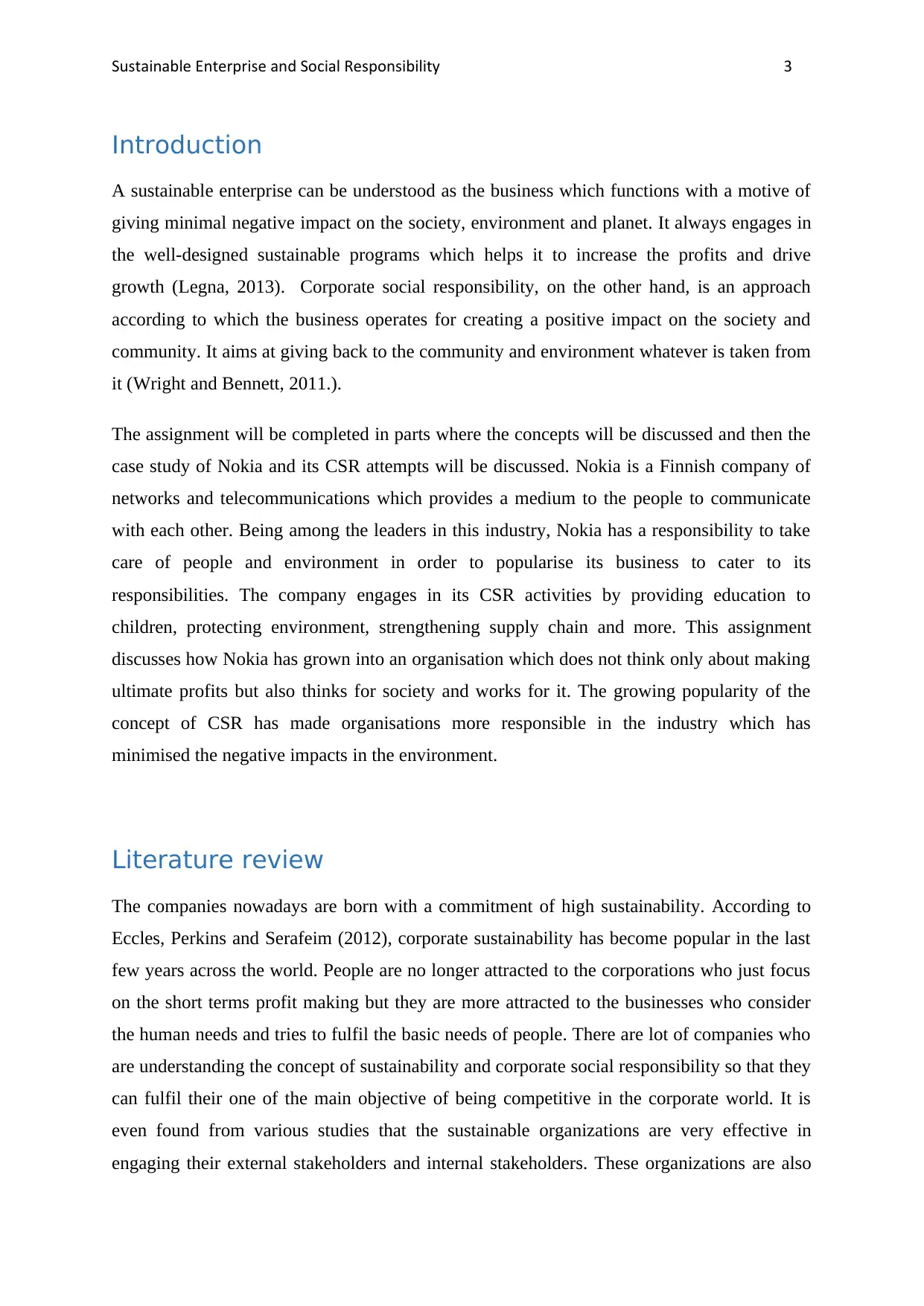
Sustainable Enterprise and Social Responsibility 3
Introduction
A sustainable enterprise can be understood as the business which functions with a motive of
giving minimal negative impact on the society, environment and planet. It always engages in
the well-designed sustainable programs which helps it to increase the profits and drive
growth (Legna, 2013). Corporate social responsibility, on the other hand, is an approach
according to which the business operates for creating a positive impact on the society and
community. It aims at giving back to the community and environment whatever is taken from
it (Wright and Bennett, 2011.).
The assignment will be completed in parts where the concepts will be discussed and then the
case study of Nokia and its CSR attempts will be discussed. Nokia is a Finnish company of
networks and telecommunications which provides a medium to the people to communicate
with each other. Being among the leaders in this industry, Nokia has a responsibility to take
care of people and environment in order to popularise its business to cater to its
responsibilities. The company engages in its CSR activities by providing education to
children, protecting environment, strengthening supply chain and more. This assignment
discusses how Nokia has grown into an organisation which does not think only about making
ultimate profits but also thinks for society and works for it. The growing popularity of the
concept of CSR has made organisations more responsible in the industry which has
minimised the negative impacts in the environment.
Literature review
The companies nowadays are born with a commitment of high sustainability. According to
Eccles, Perkins and Serafeim (2012), corporate sustainability has become popular in the last
few years across the world. People are no longer attracted to the corporations who just focus
on the short terms profit making but they are more attracted to the businesses who consider
the human needs and tries to fulfil the basic needs of people. There are lot of companies who
are understanding the concept of sustainability and corporate social responsibility so that they
can fulfil their one of the main objective of being competitive in the corporate world. It is
even found from various studies that the sustainable organizations are very effective in
engaging their external stakeholders and internal stakeholders. These organizations are also
Introduction
A sustainable enterprise can be understood as the business which functions with a motive of
giving minimal negative impact on the society, environment and planet. It always engages in
the well-designed sustainable programs which helps it to increase the profits and drive
growth (Legna, 2013). Corporate social responsibility, on the other hand, is an approach
according to which the business operates for creating a positive impact on the society and
community. It aims at giving back to the community and environment whatever is taken from
it (Wright and Bennett, 2011.).
The assignment will be completed in parts where the concepts will be discussed and then the
case study of Nokia and its CSR attempts will be discussed. Nokia is a Finnish company of
networks and telecommunications which provides a medium to the people to communicate
with each other. Being among the leaders in this industry, Nokia has a responsibility to take
care of people and environment in order to popularise its business to cater to its
responsibilities. The company engages in its CSR activities by providing education to
children, protecting environment, strengthening supply chain and more. This assignment
discusses how Nokia has grown into an organisation which does not think only about making
ultimate profits but also thinks for society and works for it. The growing popularity of the
concept of CSR has made organisations more responsible in the industry which has
minimised the negative impacts in the environment.
Literature review
The companies nowadays are born with a commitment of high sustainability. According to
Eccles, Perkins and Serafeim (2012), corporate sustainability has become popular in the last
few years across the world. People are no longer attracted to the corporations who just focus
on the short terms profit making but they are more attracted to the businesses who consider
the human needs and tries to fulfil the basic needs of people. There are lot of companies who
are understanding the concept of sustainability and corporate social responsibility so that they
can fulfil their one of the main objective of being competitive in the corporate world. It is
even found from various studies that the sustainable organizations are very effective in
engaging their external stakeholders and internal stakeholders. These organizations are also
Secure Best Marks with AI Grader
Need help grading? Try our AI Grader for instant feedback on your assignments.
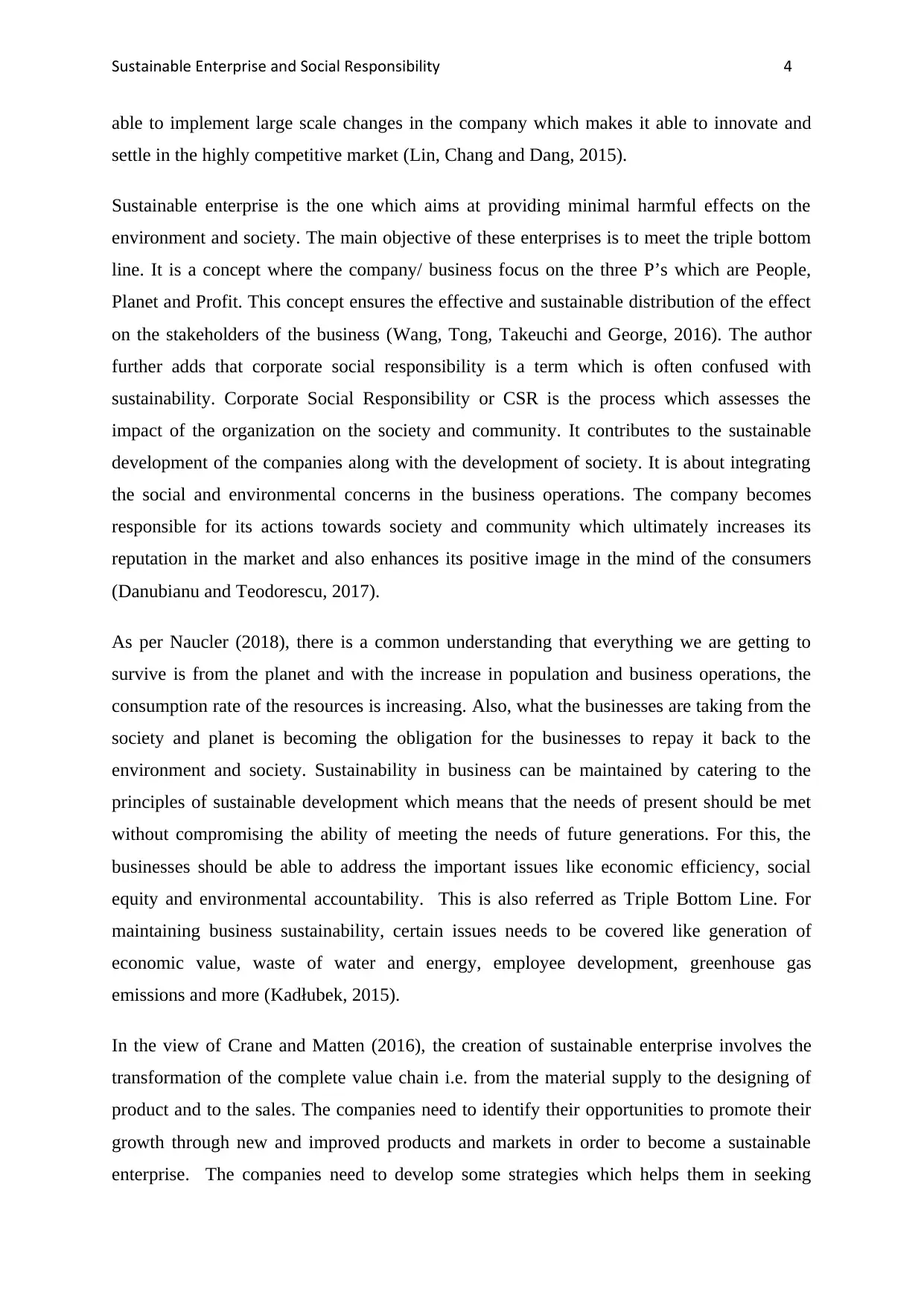
Sustainable Enterprise and Social Responsibility 4
able to implement large scale changes in the company which makes it able to innovate and
settle in the highly competitive market (Lin, Chang and Dang, 2015).
Sustainable enterprise is the one which aims at providing minimal harmful effects on the
environment and society. The main objective of these enterprises is to meet the triple bottom
line. It is a concept where the company/ business focus on the three P’s which are People,
Planet and Profit. This concept ensures the effective and sustainable distribution of the effect
on the stakeholders of the business (Wang, Tong, Takeuchi and George, 2016). The author
further adds that corporate social responsibility is a term which is often confused with
sustainability. Corporate Social Responsibility or CSR is the process which assesses the
impact of the organization on the society and community. It contributes to the sustainable
development of the companies along with the development of society. It is about integrating
the social and environmental concerns in the business operations. The company becomes
responsible for its actions towards society and community which ultimately increases its
reputation in the market and also enhances its positive image in the mind of the consumers
(Danubianu and Teodorescu, 2017).
As per Naucler (2018), there is a common understanding that everything we are getting to
survive is from the planet and with the increase in population and business operations, the
consumption rate of the resources is increasing. Also, what the businesses are taking from the
society and planet is becoming the obligation for the businesses to repay it back to the
environment and society. Sustainability in business can be maintained by catering to the
principles of sustainable development which means that the needs of present should be met
without compromising the ability of meeting the needs of future generations. For this, the
businesses should be able to address the important issues like economic efficiency, social
equity and environmental accountability. This is also referred as Triple Bottom Line. For
maintaining business sustainability, certain issues needs to be covered like generation of
economic value, waste of water and energy, employee development, greenhouse gas
emissions and more (Kadłubek, 2015).
In the view of Crane and Matten (2016), the creation of sustainable enterprise involves the
transformation of the complete value chain i.e. from the material supply to the designing of
product and to the sales. The companies need to identify their opportunities to promote their
growth through new and improved products and markets in order to become a sustainable
enterprise. The companies need to develop some strategies which helps them in seeking
able to implement large scale changes in the company which makes it able to innovate and
settle in the highly competitive market (Lin, Chang and Dang, 2015).
Sustainable enterprise is the one which aims at providing minimal harmful effects on the
environment and society. The main objective of these enterprises is to meet the triple bottom
line. It is a concept where the company/ business focus on the three P’s which are People,
Planet and Profit. This concept ensures the effective and sustainable distribution of the effect
on the stakeholders of the business (Wang, Tong, Takeuchi and George, 2016). The author
further adds that corporate social responsibility is a term which is often confused with
sustainability. Corporate Social Responsibility or CSR is the process which assesses the
impact of the organization on the society and community. It contributes to the sustainable
development of the companies along with the development of society. It is about integrating
the social and environmental concerns in the business operations. The company becomes
responsible for its actions towards society and community which ultimately increases its
reputation in the market and also enhances its positive image in the mind of the consumers
(Danubianu and Teodorescu, 2017).
As per Naucler (2018), there is a common understanding that everything we are getting to
survive is from the planet and with the increase in population and business operations, the
consumption rate of the resources is increasing. Also, what the businesses are taking from the
society and planet is becoming the obligation for the businesses to repay it back to the
environment and society. Sustainability in business can be maintained by catering to the
principles of sustainable development which means that the needs of present should be met
without compromising the ability of meeting the needs of future generations. For this, the
businesses should be able to address the important issues like economic efficiency, social
equity and environmental accountability. This is also referred as Triple Bottom Line. For
maintaining business sustainability, certain issues needs to be covered like generation of
economic value, waste of water and energy, employee development, greenhouse gas
emissions and more (Kadłubek, 2015).
In the view of Crane and Matten (2016), the creation of sustainable enterprise involves the
transformation of the complete value chain i.e. from the material supply to the designing of
product and to the sales. The companies need to identify their opportunities to promote their
growth through new and improved products and markets in order to become a sustainable
enterprise. The companies need to develop some strategies which helps them in seeking
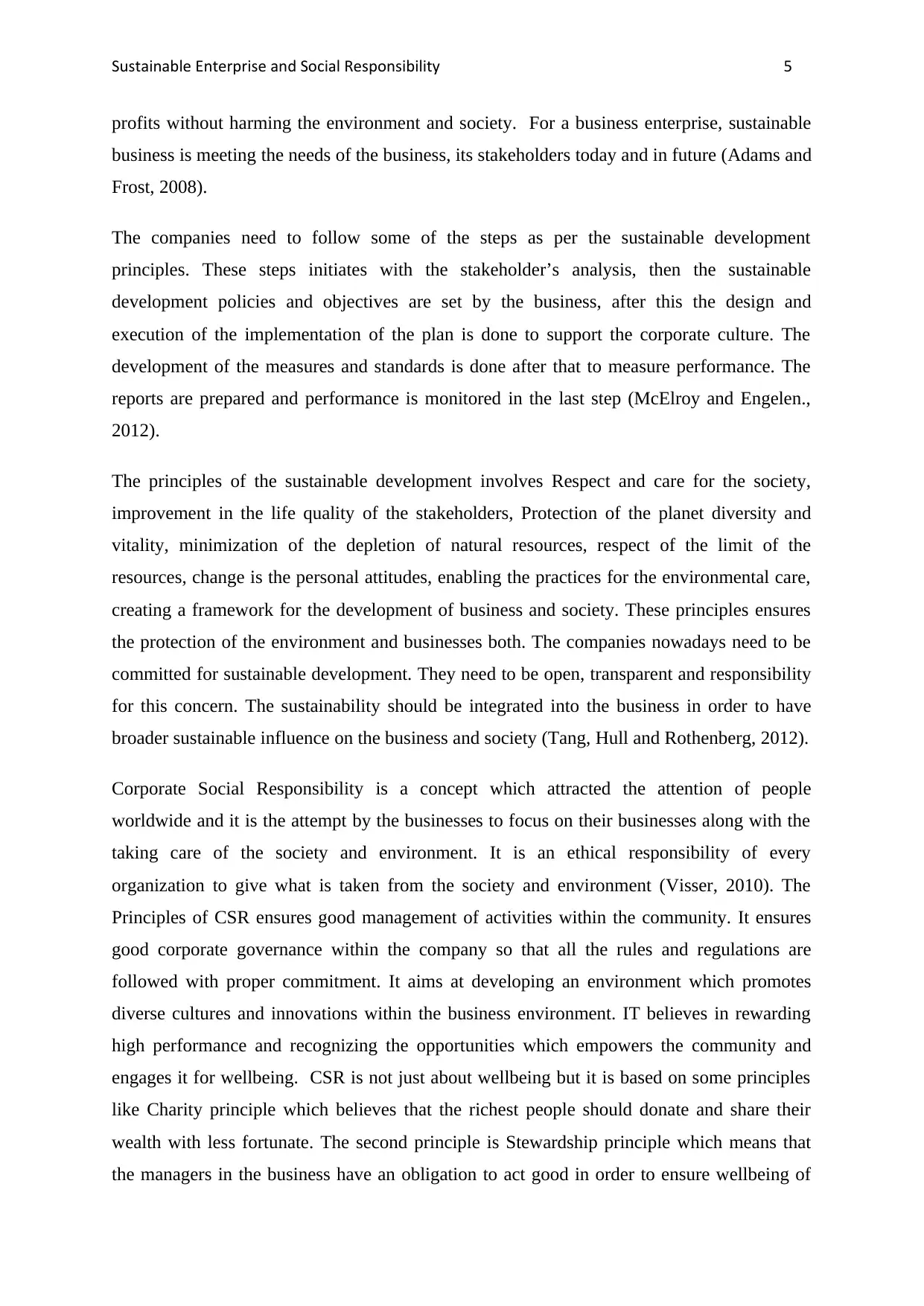
Sustainable Enterprise and Social Responsibility 5
profits without harming the environment and society. For a business enterprise, sustainable
business is meeting the needs of the business, its stakeholders today and in future (Adams and
Frost, 2008).
The companies need to follow some of the steps as per the sustainable development
principles. These steps initiates with the stakeholder’s analysis, then the sustainable
development policies and objectives are set by the business, after this the design and
execution of the implementation of the plan is done to support the corporate culture. The
development of the measures and standards is done after that to measure performance. The
reports are prepared and performance is monitored in the last step (McElroy and Engelen.,
2012).
The principles of the sustainable development involves Respect and care for the society,
improvement in the life quality of the stakeholders, Protection of the planet diversity and
vitality, minimization of the depletion of natural resources, respect of the limit of the
resources, change is the personal attitudes, enabling the practices for the environmental care,
creating a framework for the development of business and society. These principles ensures
the protection of the environment and businesses both. The companies nowadays need to be
committed for sustainable development. They need to be open, transparent and responsibility
for this concern. The sustainability should be integrated into the business in order to have
broader sustainable influence on the business and society (Tang, Hull and Rothenberg, 2012).
Corporate Social Responsibility is a concept which attracted the attention of people
worldwide and it is the attempt by the businesses to focus on their businesses along with the
taking care of the society and environment. It is an ethical responsibility of every
organization to give what is taken from the society and environment (Visser, 2010). The
Principles of CSR ensures good management of activities within the community. It ensures
good corporate governance within the company so that all the rules and regulations are
followed with proper commitment. It aims at developing an environment which promotes
diverse cultures and innovations within the business environment. IT believes in rewarding
high performance and recognizing the opportunities which empowers the community and
engages it for wellbeing. CSR is not just about wellbeing but it is based on some principles
like Charity principle which believes that the richest people should donate and share their
wealth with less fortunate. The second principle is Stewardship principle which means that
the managers in the business have an obligation to act good in order to ensure wellbeing of
profits without harming the environment and society. For a business enterprise, sustainable
business is meeting the needs of the business, its stakeholders today and in future (Adams and
Frost, 2008).
The companies need to follow some of the steps as per the sustainable development
principles. These steps initiates with the stakeholder’s analysis, then the sustainable
development policies and objectives are set by the business, after this the design and
execution of the implementation of the plan is done to support the corporate culture. The
development of the measures and standards is done after that to measure performance. The
reports are prepared and performance is monitored in the last step (McElroy and Engelen.,
2012).
The principles of the sustainable development involves Respect and care for the society,
improvement in the life quality of the stakeholders, Protection of the planet diversity and
vitality, minimization of the depletion of natural resources, respect of the limit of the
resources, change is the personal attitudes, enabling the practices for the environmental care,
creating a framework for the development of business and society. These principles ensures
the protection of the environment and businesses both. The companies nowadays need to be
committed for sustainable development. They need to be open, transparent and responsibility
for this concern. The sustainability should be integrated into the business in order to have
broader sustainable influence on the business and society (Tang, Hull and Rothenberg, 2012).
Corporate Social Responsibility is a concept which attracted the attention of people
worldwide and it is the attempt by the businesses to focus on their businesses along with the
taking care of the society and environment. It is an ethical responsibility of every
organization to give what is taken from the society and environment (Visser, 2010). The
Principles of CSR ensures good management of activities within the community. It ensures
good corporate governance within the company so that all the rules and regulations are
followed with proper commitment. It aims at developing an environment which promotes
diverse cultures and innovations within the business environment. IT believes in rewarding
high performance and recognizing the opportunities which empowers the community and
engages it for wellbeing. CSR is not just about wellbeing but it is based on some principles
like Charity principle which believes that the richest people should donate and share their
wealth with less fortunate. The second principle is Stewardship principle which means that
the managers in the business have an obligation to act good in order to ensure wellbeing of
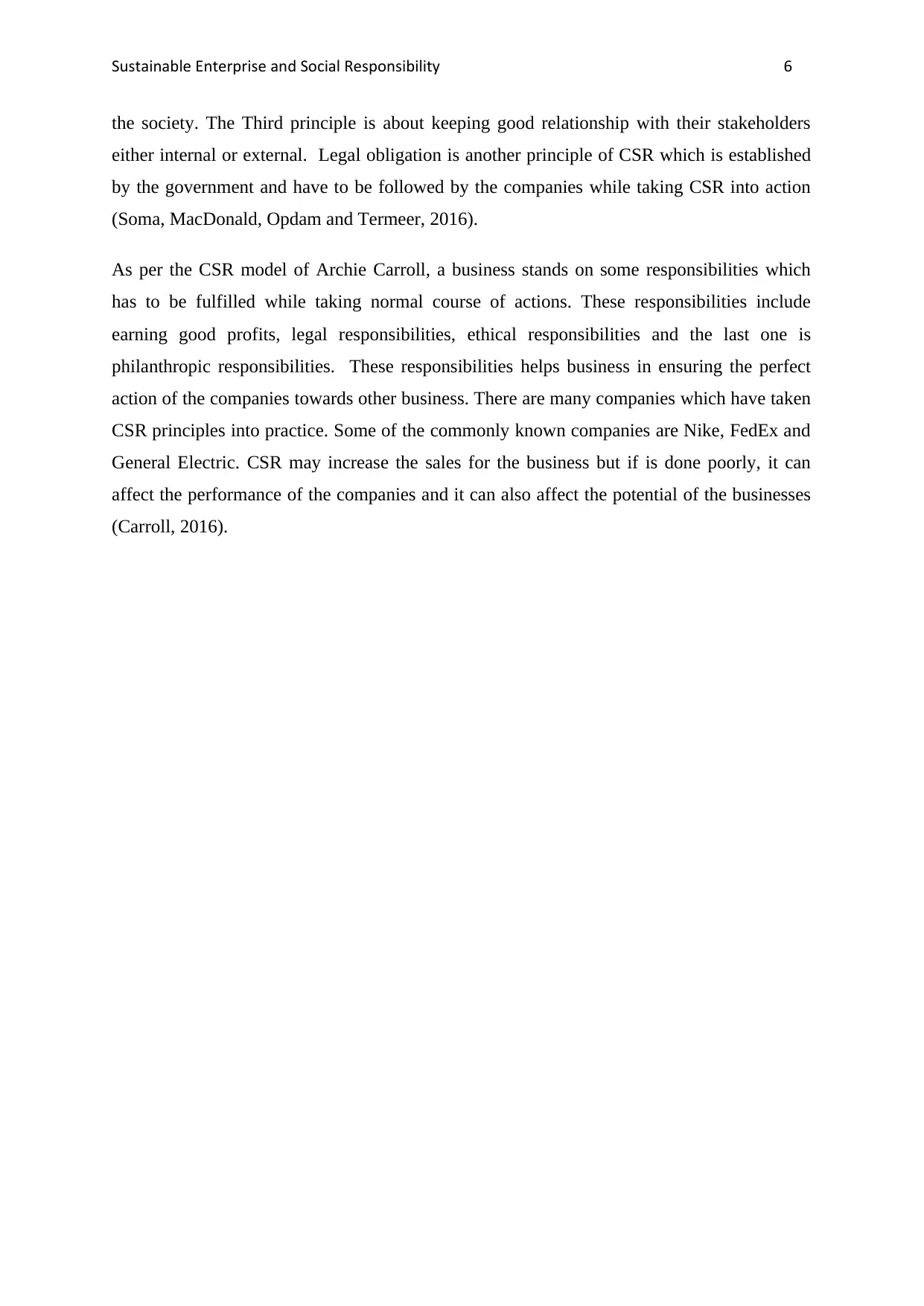
Sustainable Enterprise and Social Responsibility 6
the society. The Third principle is about keeping good relationship with their stakeholders
either internal or external. Legal obligation is another principle of CSR which is established
by the government and have to be followed by the companies while taking CSR into action
(Soma, MacDonald, Opdam and Termeer, 2016).
As per the CSR model of Archie Carroll, a business stands on some responsibilities which
has to be fulfilled while taking normal course of actions. These responsibilities include
earning good profits, legal responsibilities, ethical responsibilities and the last one is
philanthropic responsibilities. These responsibilities helps business in ensuring the perfect
action of the companies towards other business. There are many companies which have taken
CSR principles into practice. Some of the commonly known companies are Nike, FedEx and
General Electric. CSR may increase the sales for the business but if is done poorly, it can
affect the performance of the companies and it can also affect the potential of the businesses
(Carroll, 2016).
the society. The Third principle is about keeping good relationship with their stakeholders
either internal or external. Legal obligation is another principle of CSR which is established
by the government and have to be followed by the companies while taking CSR into action
(Soma, MacDonald, Opdam and Termeer, 2016).
As per the CSR model of Archie Carroll, a business stands on some responsibilities which
has to be fulfilled while taking normal course of actions. These responsibilities include
earning good profits, legal responsibilities, ethical responsibilities and the last one is
philanthropic responsibilities. These responsibilities helps business in ensuring the perfect
action of the companies towards other business. There are many companies which have taken
CSR principles into practice. Some of the commonly known companies are Nike, FedEx and
General Electric. CSR may increase the sales for the business but if is done poorly, it can
affect the performance of the companies and it can also affect the potential of the businesses
(Carroll, 2016).
Paraphrase This Document
Need a fresh take? Get an instant paraphrase of this document with our AI Paraphraser
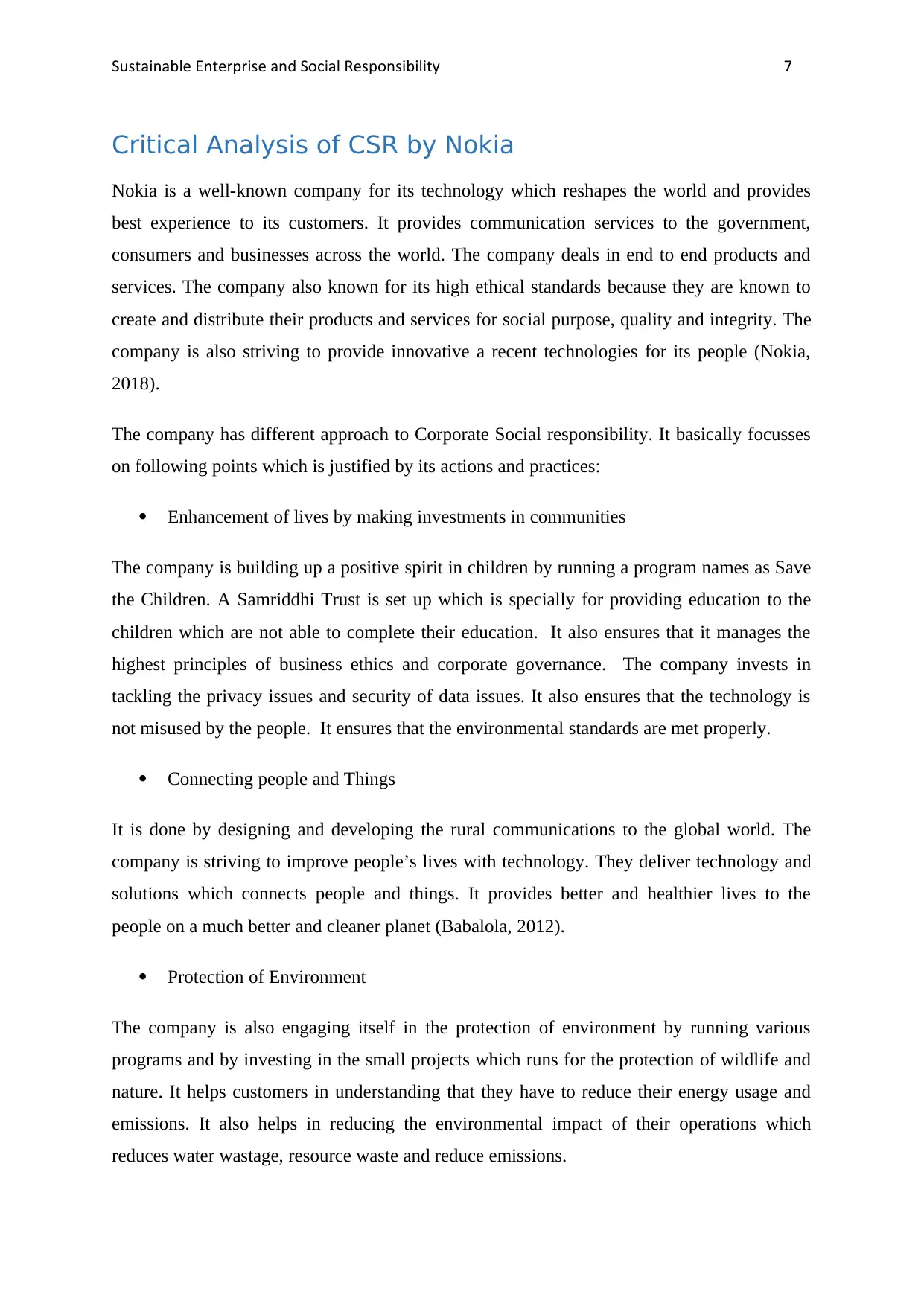
Sustainable Enterprise and Social Responsibility 7
Critical Analysis of CSR by Nokia
Nokia is a well-known company for its technology which reshapes the world and provides
best experience to its customers. It provides communication services to the government,
consumers and businesses across the world. The company deals in end to end products and
services. The company also known for its high ethical standards because they are known to
create and distribute their products and services for social purpose, quality and integrity. The
company is also striving to provide innovative a recent technologies for its people (Nokia,
2018).
The company has different approach to Corporate Social responsibility. It basically focusses
on following points which is justified by its actions and practices:
Enhancement of lives by making investments in communities
The company is building up a positive spirit in children by running a program names as Save
the Children. A Samriddhi Trust is set up which is specially for providing education to the
children which are not able to complete their education. It also ensures that it manages the
highest principles of business ethics and corporate governance. The company invests in
tackling the privacy issues and security of data issues. It also ensures that the technology is
not misused by the people. It ensures that the environmental standards are met properly.
Connecting people and Things
It is done by designing and developing the rural communications to the global world. The
company is striving to improve people’s lives with technology. They deliver technology and
solutions which connects people and things. It provides better and healthier lives to the
people on a much better and cleaner planet (Babalola, 2012).
Protection of Environment
The company is also engaging itself in the protection of environment by running various
programs and by investing in the small projects which runs for the protection of wildlife and
nature. It helps customers in understanding that they have to reduce their energy usage and
emissions. It also helps in reducing the environmental impact of their operations which
reduces water wastage, resource waste and reduce emissions.
Critical Analysis of CSR by Nokia
Nokia is a well-known company for its technology which reshapes the world and provides
best experience to its customers. It provides communication services to the government,
consumers and businesses across the world. The company deals in end to end products and
services. The company also known for its high ethical standards because they are known to
create and distribute their products and services for social purpose, quality and integrity. The
company is also striving to provide innovative a recent technologies for its people (Nokia,
2018).
The company has different approach to Corporate Social responsibility. It basically focusses
on following points which is justified by its actions and practices:
Enhancement of lives by making investments in communities
The company is building up a positive spirit in children by running a program names as Save
the Children. A Samriddhi Trust is set up which is specially for providing education to the
children which are not able to complete their education. It also ensures that it manages the
highest principles of business ethics and corporate governance. The company invests in
tackling the privacy issues and security of data issues. It also ensures that the technology is
not misused by the people. It ensures that the environmental standards are met properly.
Connecting people and Things
It is done by designing and developing the rural communications to the global world. The
company is striving to improve people’s lives with technology. They deliver technology and
solutions which connects people and things. It provides better and healthier lives to the
people on a much better and cleaner planet (Babalola, 2012).
Protection of Environment
The company is also engaging itself in the protection of environment by running various
programs and by investing in the small projects which runs for the protection of wildlife and
nature. It helps customers in understanding that they have to reduce their energy usage and
emissions. It also helps in reducing the environmental impact of their operations which
reduces water wastage, resource waste and reduce emissions.
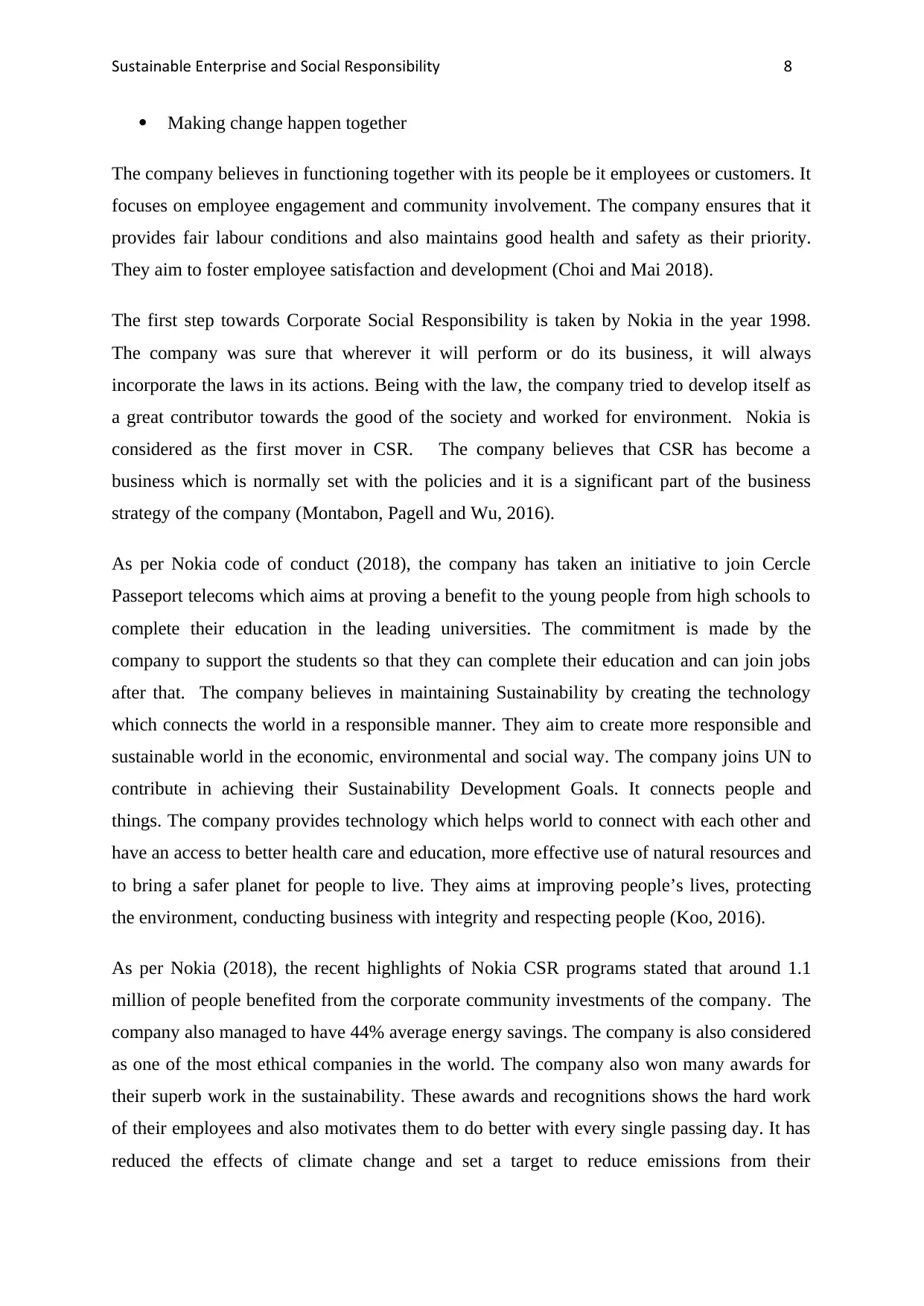
Sustainable Enterprise and Social Responsibility 8
Making change happen together
The company believes in functioning together with its people be it employees or customers. It
focuses on employee engagement and community involvement. The company ensures that it
provides fair labour conditions and also maintains good health and safety as their priority.
They aim to foster employee satisfaction and development (Choi and Mai 2018).
The first step towards Corporate Social Responsibility is taken by Nokia in the year 1998.
The company was sure that wherever it will perform or do its business, it will always
incorporate the laws in its actions. Being with the law, the company tried to develop itself as
a great contributor towards the good of the society and worked for environment. Nokia is
considered as the first mover in CSR. The company believes that CSR has become a
business which is normally set with the policies and it is a significant part of the business
strategy of the company (Montabon, Pagell and Wu, 2016).
As per Nokia code of conduct (2018), the company has taken an initiative to join Cercle
Passeport telecoms which aims at proving a benefit to the young people from high schools to
complete their education in the leading universities. The commitment is made by the
company to support the students so that they can complete their education and can join jobs
after that. The company believes in maintaining Sustainability by creating the technology
which connects the world in a responsible manner. They aim to create more responsible and
sustainable world in the economic, environmental and social way. The company joins UN to
contribute in achieving their Sustainability Development Goals. It connects people and
things. The company provides technology which helps world to connect with each other and
have an access to better health care and education, more effective use of natural resources and
to bring a safer planet for people to live. They aims at improving people’s lives, protecting
the environment, conducting business with integrity and respecting people (Koo, 2016).
As per Nokia (2018), the recent highlights of Nokia CSR programs stated that around 1.1
million of people benefited from the corporate community investments of the company. The
company also managed to have 44% average energy savings. The company is also considered
as one of the most ethical companies in the world. The company also won many awards for
their superb work in the sustainability. These awards and recognitions shows the hard work
of their employees and also motivates them to do better with every single passing day. It has
reduced the effects of climate change and set a target to reduce emissions from their
Making change happen together
The company believes in functioning together with its people be it employees or customers. It
focuses on employee engagement and community involvement. The company ensures that it
provides fair labour conditions and also maintains good health and safety as their priority.
They aim to foster employee satisfaction and development (Choi and Mai 2018).
The first step towards Corporate Social Responsibility is taken by Nokia in the year 1998.
The company was sure that wherever it will perform or do its business, it will always
incorporate the laws in its actions. Being with the law, the company tried to develop itself as
a great contributor towards the good of the society and worked for environment. Nokia is
considered as the first mover in CSR. The company believes that CSR has become a
business which is normally set with the policies and it is a significant part of the business
strategy of the company (Montabon, Pagell and Wu, 2016).
As per Nokia code of conduct (2018), the company has taken an initiative to join Cercle
Passeport telecoms which aims at proving a benefit to the young people from high schools to
complete their education in the leading universities. The commitment is made by the
company to support the students so that they can complete their education and can join jobs
after that. The company believes in maintaining Sustainability by creating the technology
which connects the world in a responsible manner. They aim to create more responsible and
sustainable world in the economic, environmental and social way. The company joins UN to
contribute in achieving their Sustainability Development Goals. It connects people and
things. The company provides technology which helps world to connect with each other and
have an access to better health care and education, more effective use of natural resources and
to bring a safer planet for people to live. They aims at improving people’s lives, protecting
the environment, conducting business with integrity and respecting people (Koo, 2016).
As per Nokia (2018), the recent highlights of Nokia CSR programs stated that around 1.1
million of people benefited from the corporate community investments of the company. The
company also managed to have 44% average energy savings. The company is also considered
as one of the most ethical companies in the world. The company also won many awards for
their superb work in the sustainability. These awards and recognitions shows the hard work
of their employees and also motivates them to do better with every single passing day. It has
reduced the effects of climate change and set a target to reduce emissions from their
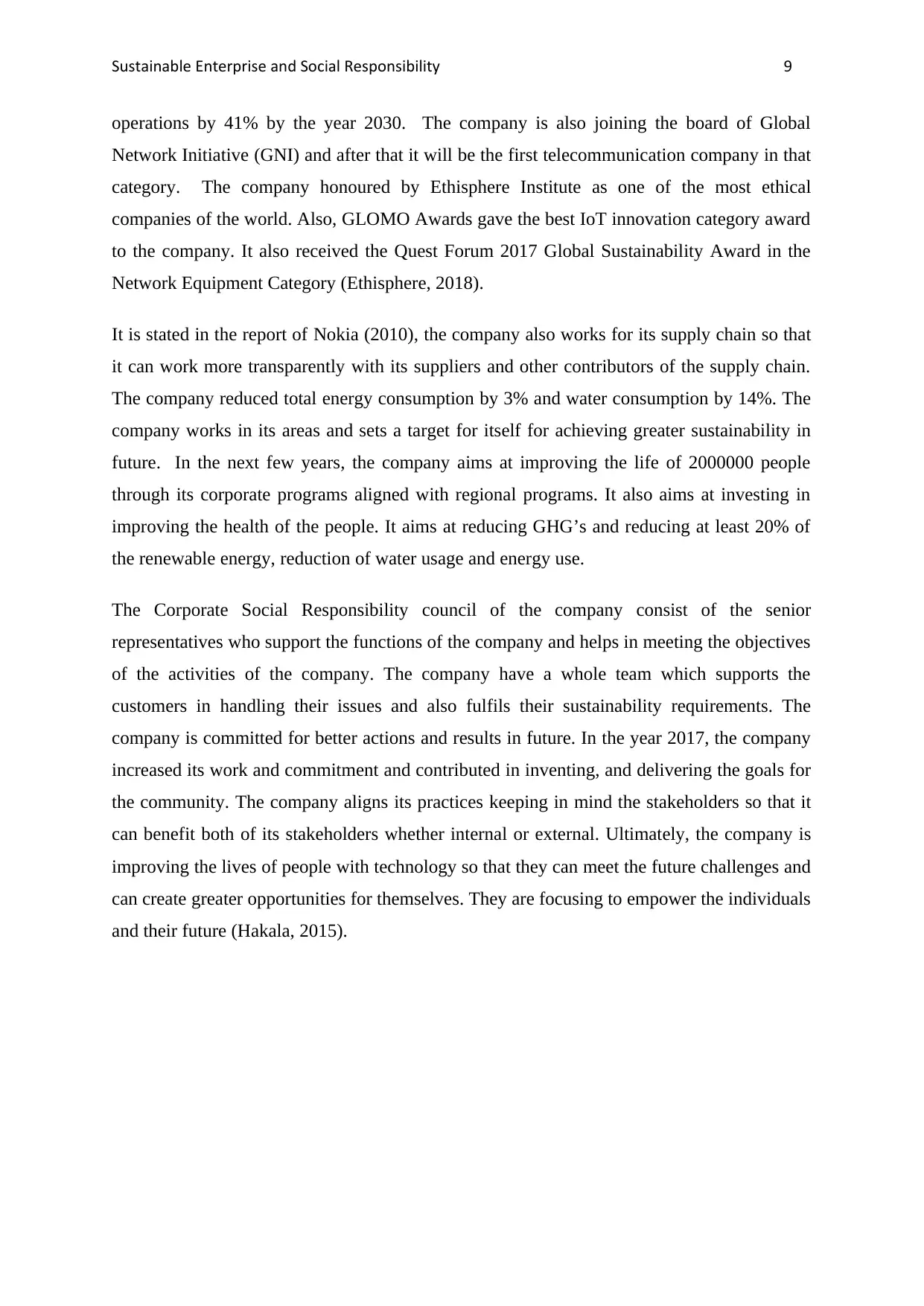
Sustainable Enterprise and Social Responsibility 9
operations by 41% by the year 2030. The company is also joining the board of Global
Network Initiative (GNI) and after that it will be the first telecommunication company in that
category. The company honoured by Ethisphere Institute as one of the most ethical
companies of the world. Also, GLOMO Awards gave the best IoT innovation category award
to the company. It also received the Quest Forum 2017 Global Sustainability Award in the
Network Equipment Category (Ethisphere, 2018).
It is stated in the report of Nokia (2010), the company also works for its supply chain so that
it can work more transparently with its suppliers and other contributors of the supply chain.
The company reduced total energy consumption by 3% and water consumption by 14%. The
company works in its areas and sets a target for itself for achieving greater sustainability in
future. In the next few years, the company aims at improving the life of 2000000 people
through its corporate programs aligned with regional programs. It also aims at investing in
improving the health of the people. It aims at reducing GHG’s and reducing at least 20% of
the renewable energy, reduction of water usage and energy use.
The Corporate Social Responsibility council of the company consist of the senior
representatives who support the functions of the company and helps in meeting the objectives
of the activities of the company. The company have a whole team which supports the
customers in handling their issues and also fulfils their sustainability requirements. The
company is committed for better actions and results in future. In the year 2017, the company
increased its work and commitment and contributed in inventing, and delivering the goals for
the community. The company aligns its practices keeping in mind the stakeholders so that it
can benefit both of its stakeholders whether internal or external. Ultimately, the company is
improving the lives of people with technology so that they can meet the future challenges and
can create greater opportunities for themselves. They are focusing to empower the individuals
and their future (Hakala, 2015).
operations by 41% by the year 2030. The company is also joining the board of Global
Network Initiative (GNI) and after that it will be the first telecommunication company in that
category. The company honoured by Ethisphere Institute as one of the most ethical
companies of the world. Also, GLOMO Awards gave the best IoT innovation category award
to the company. It also received the Quest Forum 2017 Global Sustainability Award in the
Network Equipment Category (Ethisphere, 2018).
It is stated in the report of Nokia (2010), the company also works for its supply chain so that
it can work more transparently with its suppliers and other contributors of the supply chain.
The company reduced total energy consumption by 3% and water consumption by 14%. The
company works in its areas and sets a target for itself for achieving greater sustainability in
future. In the next few years, the company aims at improving the life of 2000000 people
through its corporate programs aligned with regional programs. It also aims at investing in
improving the health of the people. It aims at reducing GHG’s and reducing at least 20% of
the renewable energy, reduction of water usage and energy use.
The Corporate Social Responsibility council of the company consist of the senior
representatives who support the functions of the company and helps in meeting the objectives
of the activities of the company. The company have a whole team which supports the
customers in handling their issues and also fulfils their sustainability requirements. The
company is committed for better actions and results in future. In the year 2017, the company
increased its work and commitment and contributed in inventing, and delivering the goals for
the community. The company aligns its practices keeping in mind the stakeholders so that it
can benefit both of its stakeholders whether internal or external. Ultimately, the company is
improving the lives of people with technology so that they can meet the future challenges and
can create greater opportunities for themselves. They are focusing to empower the individuals
and their future (Hakala, 2015).
Secure Best Marks with AI Grader
Need help grading? Try our AI Grader for instant feedback on your assignments.
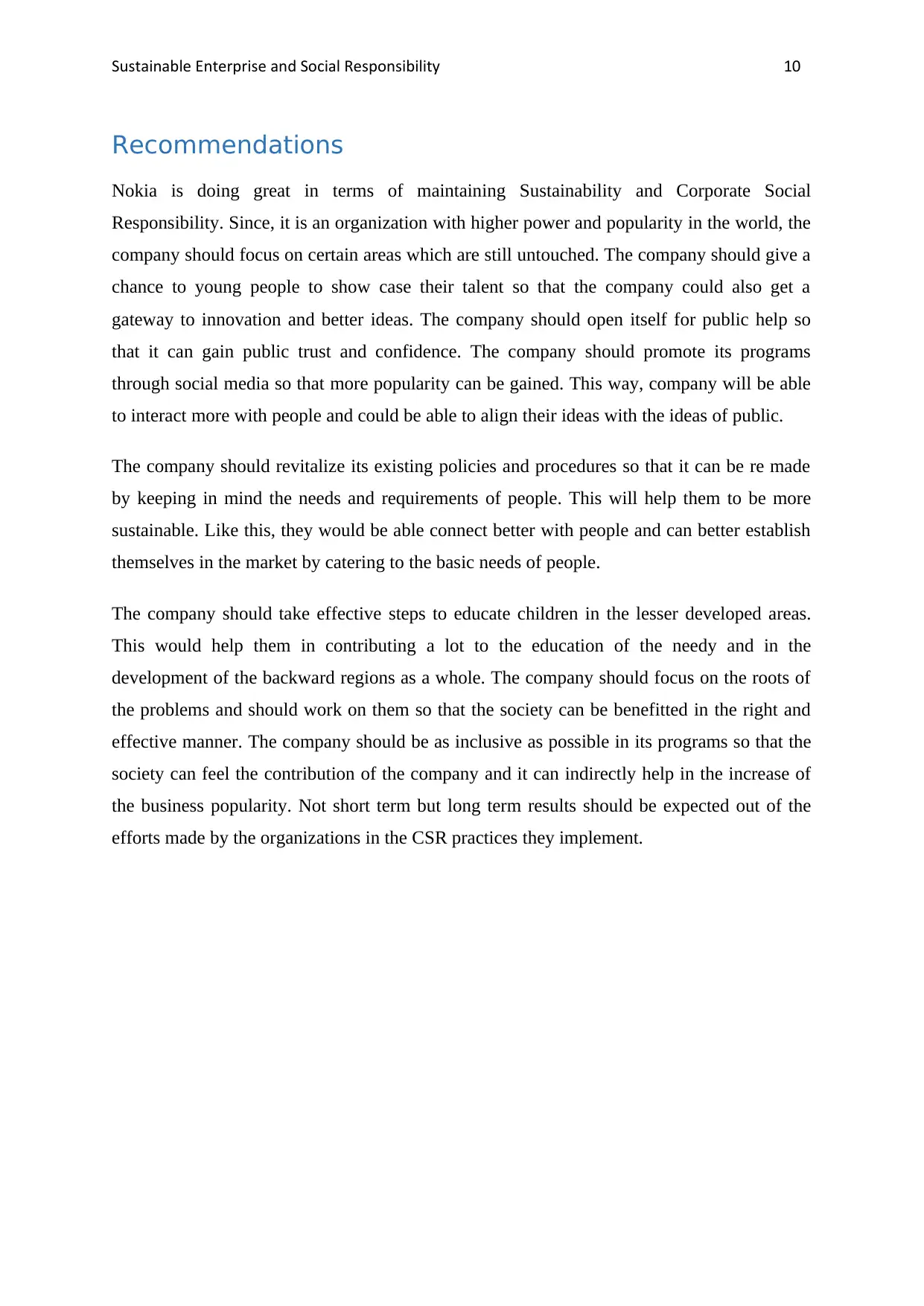
Sustainable Enterprise and Social Responsibility 10
Recommendations
Nokia is doing great in terms of maintaining Sustainability and Corporate Social
Responsibility. Since, it is an organization with higher power and popularity in the world, the
company should focus on certain areas which are still untouched. The company should give a
chance to young people to show case their talent so that the company could also get a
gateway to innovation and better ideas. The company should open itself for public help so
that it can gain public trust and confidence. The company should promote its programs
through social media so that more popularity can be gained. This way, company will be able
to interact more with people and could be able to align their ideas with the ideas of public.
The company should revitalize its existing policies and procedures so that it can be re made
by keeping in mind the needs and requirements of people. This will help them to be more
sustainable. Like this, they would be able connect better with people and can better establish
themselves in the market by catering to the basic needs of people.
The company should take effective steps to educate children in the lesser developed areas.
This would help them in contributing a lot to the education of the needy and in the
development of the backward regions as a whole. The company should focus on the roots of
the problems and should work on them so that the society can be benefitted in the right and
effective manner. The company should be as inclusive as possible in its programs so that the
society can feel the contribution of the company and it can indirectly help in the increase of
the business popularity. Not short term but long term results should be expected out of the
efforts made by the organizations in the CSR practices they implement.
Recommendations
Nokia is doing great in terms of maintaining Sustainability and Corporate Social
Responsibility. Since, it is an organization with higher power and popularity in the world, the
company should focus on certain areas which are still untouched. The company should give a
chance to young people to show case their talent so that the company could also get a
gateway to innovation and better ideas. The company should open itself for public help so
that it can gain public trust and confidence. The company should promote its programs
through social media so that more popularity can be gained. This way, company will be able
to interact more with people and could be able to align their ideas with the ideas of public.
The company should revitalize its existing policies and procedures so that it can be re made
by keeping in mind the needs and requirements of people. This will help them to be more
sustainable. Like this, they would be able connect better with people and can better establish
themselves in the market by catering to the basic needs of people.
The company should take effective steps to educate children in the lesser developed areas.
This would help them in contributing a lot to the education of the needy and in the
development of the backward regions as a whole. The company should focus on the roots of
the problems and should work on them so that the society can be benefitted in the right and
effective manner. The company should be as inclusive as possible in its programs so that the
society can feel the contribution of the company and it can indirectly help in the increase of
the business popularity. Not short term but long term results should be expected out of the
efforts made by the organizations in the CSR practices they implement.
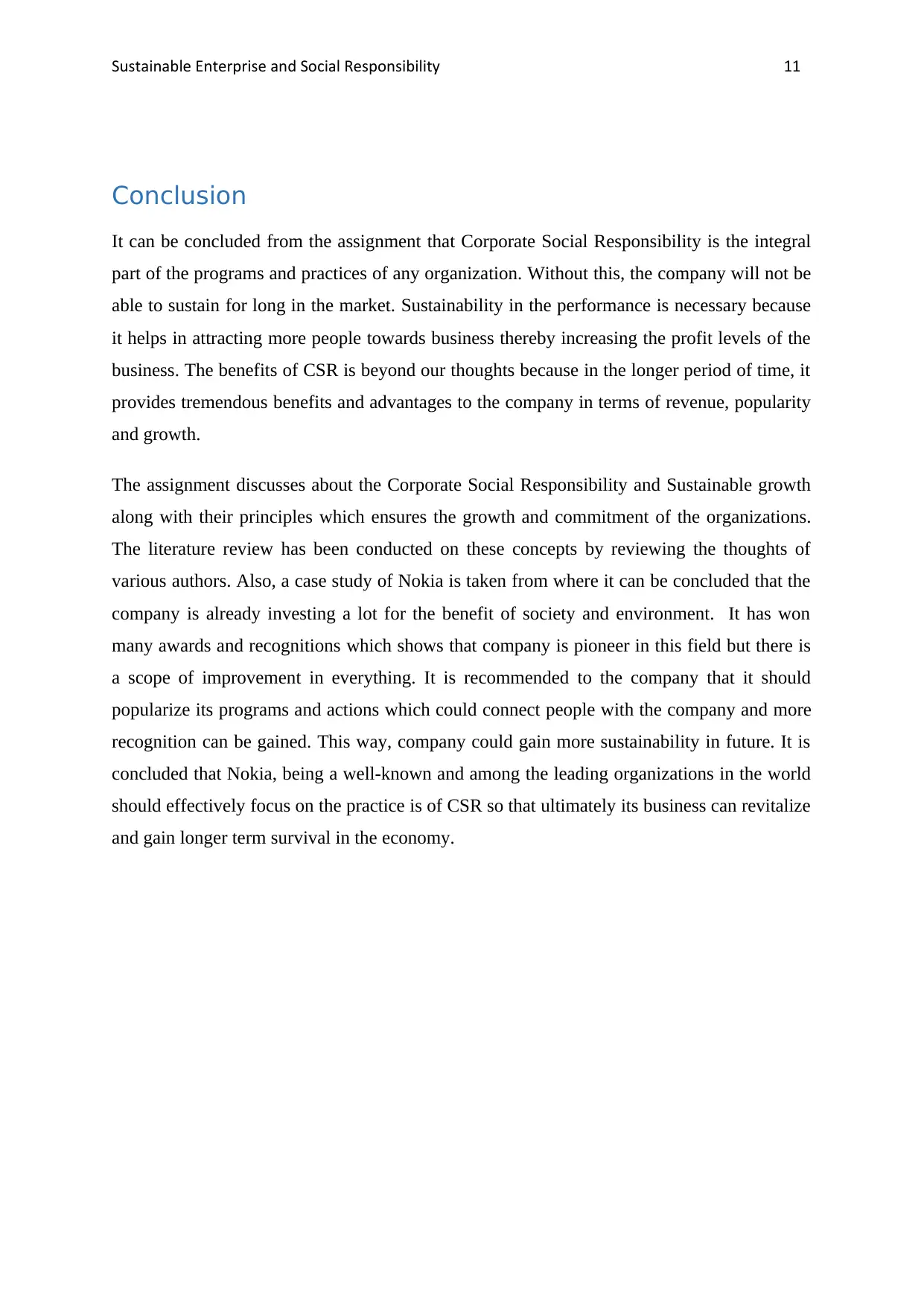
Sustainable Enterprise and Social Responsibility 11
Conclusion
It can be concluded from the assignment that Corporate Social Responsibility is the integral
part of the programs and practices of any organization. Without this, the company will not be
able to sustain for long in the market. Sustainability in the performance is necessary because
it helps in attracting more people towards business thereby increasing the profit levels of the
business. The benefits of CSR is beyond our thoughts because in the longer period of time, it
provides tremendous benefits and advantages to the company in terms of revenue, popularity
and growth.
The assignment discusses about the Corporate Social Responsibility and Sustainable growth
along with their principles which ensures the growth and commitment of the organizations.
The literature review has been conducted on these concepts by reviewing the thoughts of
various authors. Also, a case study of Nokia is taken from where it can be concluded that the
company is already investing a lot for the benefit of society and environment. It has won
many awards and recognitions which shows that company is pioneer in this field but there is
a scope of improvement in everything. It is recommended to the company that it should
popularize its programs and actions which could connect people with the company and more
recognition can be gained. This way, company could gain more sustainability in future. It is
concluded that Nokia, being a well-known and among the leading organizations in the world
should effectively focus on the practice is of CSR so that ultimately its business can revitalize
and gain longer term survival in the economy.
Conclusion
It can be concluded from the assignment that Corporate Social Responsibility is the integral
part of the programs and practices of any organization. Without this, the company will not be
able to sustain for long in the market. Sustainability in the performance is necessary because
it helps in attracting more people towards business thereby increasing the profit levels of the
business. The benefits of CSR is beyond our thoughts because in the longer period of time, it
provides tremendous benefits and advantages to the company in terms of revenue, popularity
and growth.
The assignment discusses about the Corporate Social Responsibility and Sustainable growth
along with their principles which ensures the growth and commitment of the organizations.
The literature review has been conducted on these concepts by reviewing the thoughts of
various authors. Also, a case study of Nokia is taken from where it can be concluded that the
company is already investing a lot for the benefit of society and environment. It has won
many awards and recognitions which shows that company is pioneer in this field but there is
a scope of improvement in everything. It is recommended to the company that it should
popularize its programs and actions which could connect people with the company and more
recognition can be gained. This way, company could gain more sustainability in future. It is
concluded that Nokia, being a well-known and among the leading organizations in the world
should effectively focus on the practice is of CSR so that ultimately its business can revitalize
and gain longer term survival in the economy.
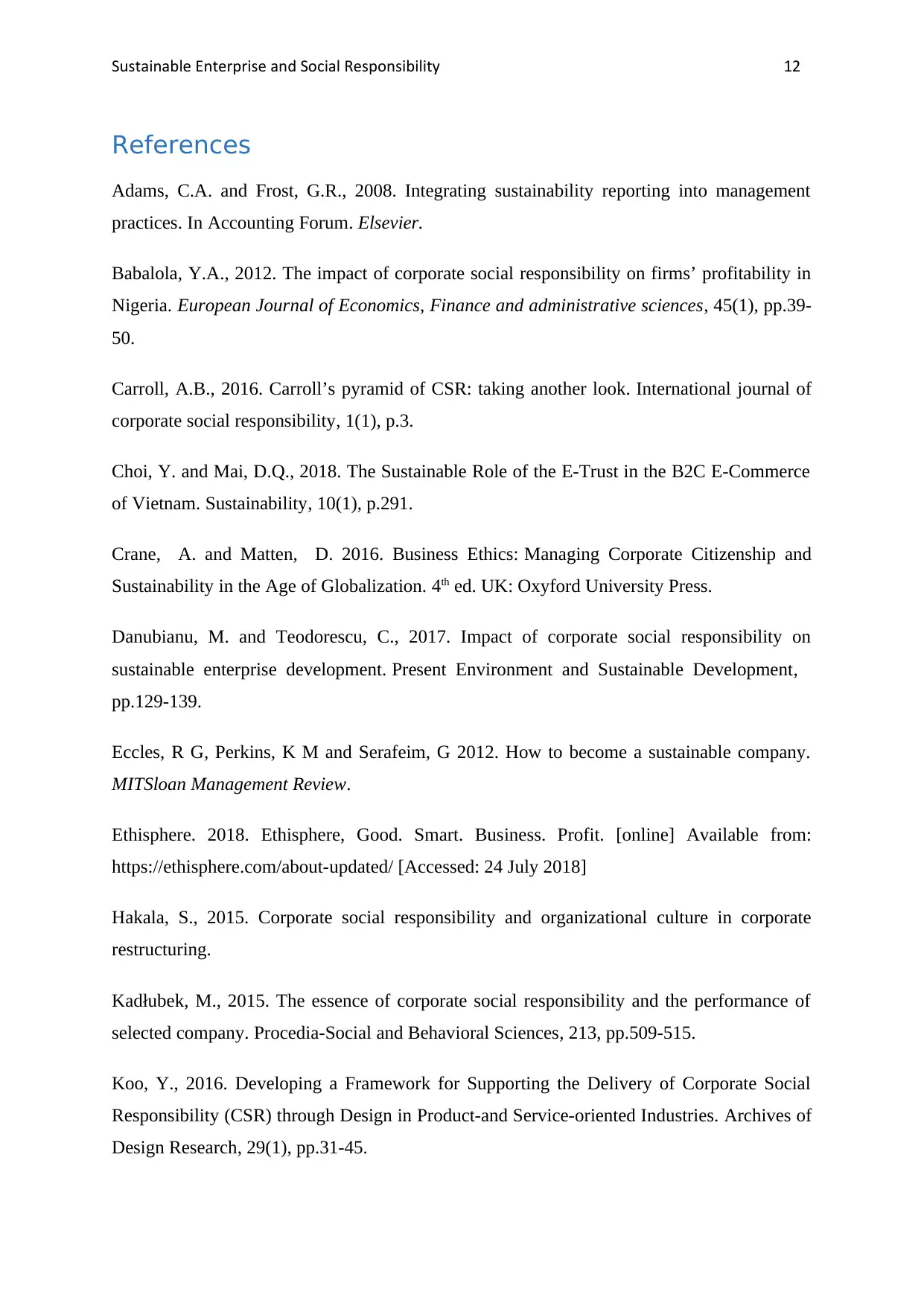
Sustainable Enterprise and Social Responsibility 12
References
Adams, C.A. and Frost, G.R., 2008. Integrating sustainability reporting into management
practices. In Accounting Forum. Elsevier.
Babalola, Y.A., 2012. The impact of corporate social responsibility on firms’ profitability in
Nigeria. European Journal of Economics, Finance and administrative sciences, 45(1), pp.39-
50.
Carroll, A.B., 2016. Carroll’s pyramid of CSR: taking another look. International journal of
corporate social responsibility, 1(1), p.3.
Choi, Y. and Mai, D.Q., 2018. The Sustainable Role of the E-Trust in the B2C E-Commerce
of Vietnam. Sustainability, 10(1), p.291.
Crane, A. and Matten, D. 2016. Business Ethics: Managing Corporate Citizenship and
Sustainability in the Age of Globalization. 4th ed. UK: Oxyford University Press.
Danubianu, M. and Teodorescu, C., 2017. Impact of corporate social responsibility on
sustainable enterprise development. Present Environment and Sustainable Development,
pp.129-139.
Eccles, R G, Perkins, K M and Serafeim, G 2012. How to become a sustainable company.
MITSloan Management Review.
Ethisphere. 2018. Ethisphere, Good. Smart. Business. Profit. [online] Available from:
https://ethisphere.com/about-updated/ [Accessed: 24 July 2018]
Hakala, S., 2015. Corporate social responsibility and organizational culture in corporate
restructuring.
Kadłubek, M., 2015. The essence of corporate social responsibility and the performance of
selected company. Procedia-Social and Behavioral Sciences, 213, pp.509-515.
Koo, Y., 2016. Developing a Framework for Supporting the Delivery of Corporate Social
Responsibility (CSR) through Design in Product-and Service-oriented Industries. Archives of
Design Research, 29(1), pp.31-45.
References
Adams, C.A. and Frost, G.R., 2008. Integrating sustainability reporting into management
practices. In Accounting Forum. Elsevier.
Babalola, Y.A., 2012. The impact of corporate social responsibility on firms’ profitability in
Nigeria. European Journal of Economics, Finance and administrative sciences, 45(1), pp.39-
50.
Carroll, A.B., 2016. Carroll’s pyramid of CSR: taking another look. International journal of
corporate social responsibility, 1(1), p.3.
Choi, Y. and Mai, D.Q., 2018. The Sustainable Role of the E-Trust in the B2C E-Commerce
of Vietnam. Sustainability, 10(1), p.291.
Crane, A. and Matten, D. 2016. Business Ethics: Managing Corporate Citizenship and
Sustainability in the Age of Globalization. 4th ed. UK: Oxyford University Press.
Danubianu, M. and Teodorescu, C., 2017. Impact of corporate social responsibility on
sustainable enterprise development. Present Environment and Sustainable Development,
pp.129-139.
Eccles, R G, Perkins, K M and Serafeim, G 2012. How to become a sustainable company.
MITSloan Management Review.
Ethisphere. 2018. Ethisphere, Good. Smart. Business. Profit. [online] Available from:
https://ethisphere.com/about-updated/ [Accessed: 24 July 2018]
Hakala, S., 2015. Corporate social responsibility and organizational culture in corporate
restructuring.
Kadłubek, M., 2015. The essence of corporate social responsibility and the performance of
selected company. Procedia-Social and Behavioral Sciences, 213, pp.509-515.
Koo, Y., 2016. Developing a Framework for Supporting the Delivery of Corporate Social
Responsibility (CSR) through Design in Product-and Service-oriented Industries. Archives of
Design Research, 29(1), pp.31-45.
Paraphrase This Document
Need a fresh take? Get an instant paraphrase of this document with our AI Paraphraser
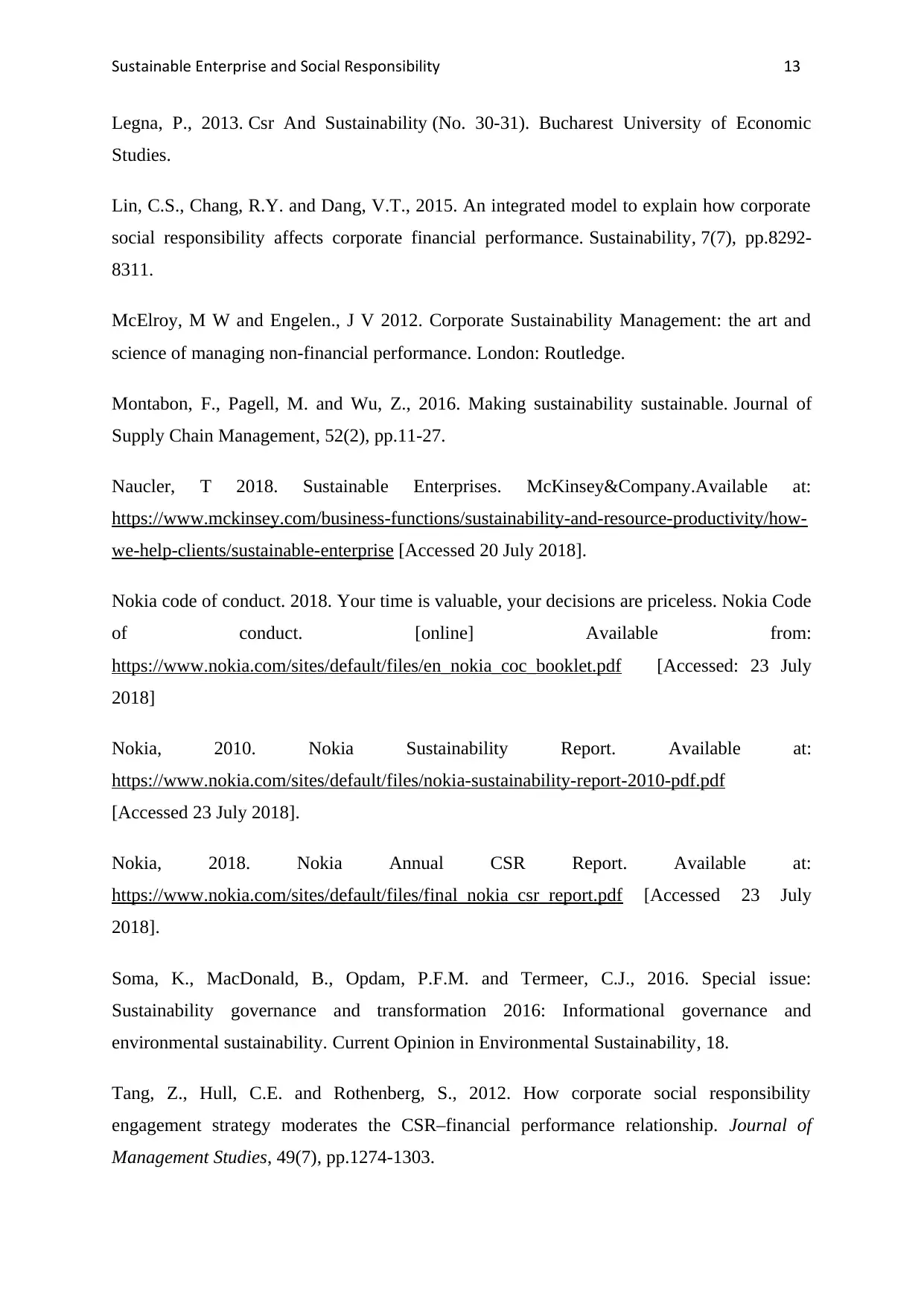
Sustainable Enterprise and Social Responsibility 13
Legna, P., 2013. Csr And Sustainability (No. 30-31). Bucharest University of Economic
Studies.
Lin, C.S., Chang, R.Y. and Dang, V.T., 2015. An integrated model to explain how corporate
social responsibility affects corporate financial performance. Sustainability, 7(7), pp.8292-
8311.
McElroy, M W and Engelen., J V 2012. Corporate Sustainability Management: the art and
science of managing non-financial performance. London: Routledge.
Montabon, F., Pagell, M. and Wu, Z., 2016. Making sustainability sustainable. Journal of
Supply Chain Management, 52(2), pp.11-27.
Naucler, T 2018. Sustainable Enterprises. McKinsey&Company.Available at:
https://www.mckinsey.com/business-functions/sustainability-and-resource-productivity/how-
we-help-clients/sustainable-enterprise [Accessed 20 July 2018].
Nokia code of conduct. 2018. Your time is valuable, your decisions are priceless. Nokia Code
of conduct. [online] Available from:
https://www.nokia.com/sites/default/files/en_nokia_coc_booklet.pdf [Accessed: 23 July
2018]
Nokia, 2010. Nokia Sustainability Report. Available at:
https://www.nokia.com/sites/default/files/nokia-sustainability-report-2010-pdf.pdf
[Accessed 23 July 2018].
Nokia, 2018. Nokia Annual CSR Report. Available at:
https://www.nokia.com/sites/default/files/final_nokia_csr_report.pdf [Accessed 23 July
2018].
Soma, K., MacDonald, B., Opdam, P.F.M. and Termeer, C.J., 2016. Special issue:
Sustainability governance and transformation 2016: Informational governance and
environmental sustainability. Current Opinion in Environmental Sustainability, 18.
Tang, Z., Hull, C.E. and Rothenberg, S., 2012. How corporate social responsibility
engagement strategy moderates the CSR–financial performance relationship. Journal of
Management Studies, 49(7), pp.1274-1303.
Legna, P., 2013. Csr And Sustainability (No. 30-31). Bucharest University of Economic
Studies.
Lin, C.S., Chang, R.Y. and Dang, V.T., 2015. An integrated model to explain how corporate
social responsibility affects corporate financial performance. Sustainability, 7(7), pp.8292-
8311.
McElroy, M W and Engelen., J V 2012. Corporate Sustainability Management: the art and
science of managing non-financial performance. London: Routledge.
Montabon, F., Pagell, M. and Wu, Z., 2016. Making sustainability sustainable. Journal of
Supply Chain Management, 52(2), pp.11-27.
Naucler, T 2018. Sustainable Enterprises. McKinsey&Company.Available at:
https://www.mckinsey.com/business-functions/sustainability-and-resource-productivity/how-
we-help-clients/sustainable-enterprise [Accessed 20 July 2018].
Nokia code of conduct. 2018. Your time is valuable, your decisions are priceless. Nokia Code
of conduct. [online] Available from:
https://www.nokia.com/sites/default/files/en_nokia_coc_booklet.pdf [Accessed: 23 July
2018]
Nokia, 2010. Nokia Sustainability Report. Available at:
https://www.nokia.com/sites/default/files/nokia-sustainability-report-2010-pdf.pdf
[Accessed 23 July 2018].
Nokia, 2018. Nokia Annual CSR Report. Available at:
https://www.nokia.com/sites/default/files/final_nokia_csr_report.pdf [Accessed 23 July
2018].
Soma, K., MacDonald, B., Opdam, P.F.M. and Termeer, C.J., 2016. Special issue:
Sustainability governance and transformation 2016: Informational governance and
environmental sustainability. Current Opinion in Environmental Sustainability, 18.
Tang, Z., Hull, C.E. and Rothenberg, S., 2012. How corporate social responsibility
engagement strategy moderates the CSR–financial performance relationship. Journal of
Management Studies, 49(7), pp.1274-1303.
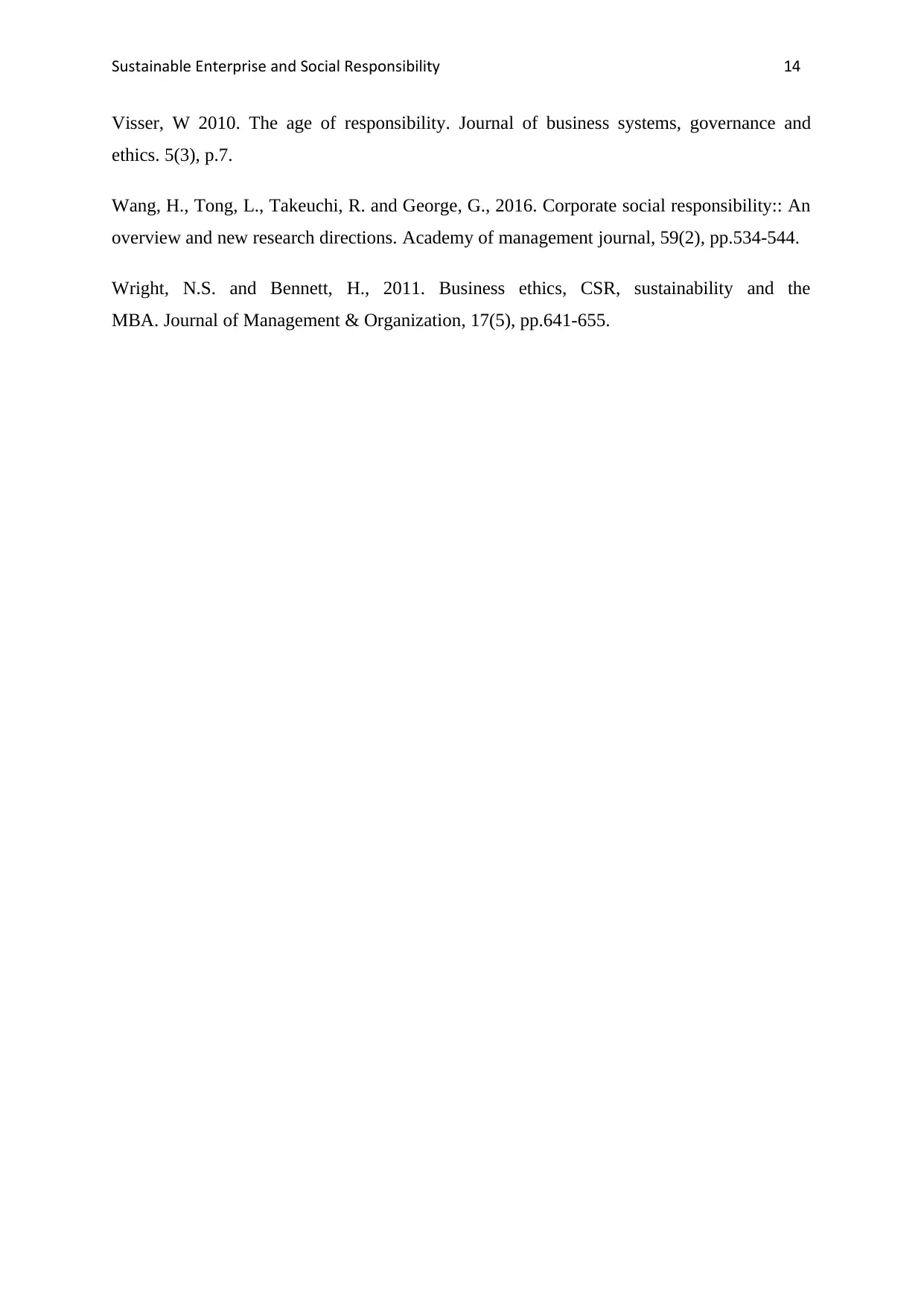
Sustainable Enterprise and Social Responsibility 14
Visser, W 2010. The age of responsibility. Journal of business systems, governance and
ethics. 5(3), p.7.
Wang, H., Tong, L., Takeuchi, R. and George, G., 2016. Corporate social responsibility:: An
overview and new research directions. Academy of management journal, 59(2), pp.534-544.
Wright, N.S. and Bennett, H., 2011. Business ethics, CSR, sustainability and the
MBA. Journal of Management & Organization, 17(5), pp.641-655.
Visser, W 2010. The age of responsibility. Journal of business systems, governance and
ethics. 5(3), p.7.
Wang, H., Tong, L., Takeuchi, R. and George, G., 2016. Corporate social responsibility:: An
overview and new research directions. Academy of management journal, 59(2), pp.534-544.
Wright, N.S. and Bennett, H., 2011. Business ethics, CSR, sustainability and the
MBA. Journal of Management & Organization, 17(5), pp.641-655.
1 out of 15
Related Documents
Your All-in-One AI-Powered Toolkit for Academic Success.
+13062052269
info@desklib.com
Available 24*7 on WhatsApp / Email
![[object Object]](/_next/static/media/star-bottom.7253800d.svg)
Unlock your academic potential
© 2024 | Zucol Services PVT LTD | All rights reserved.





